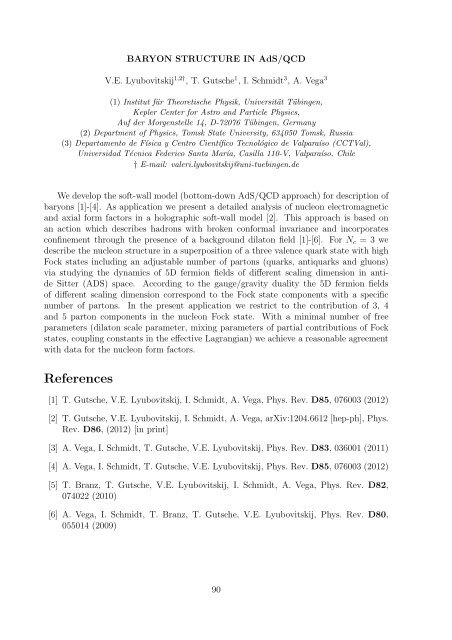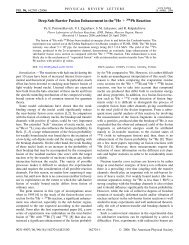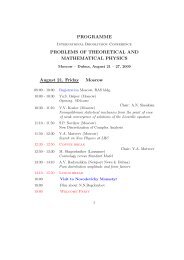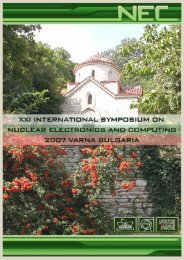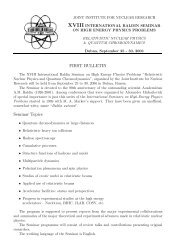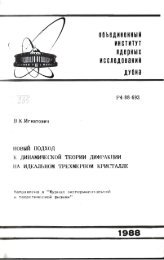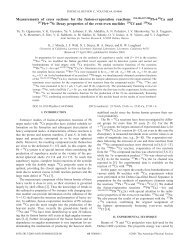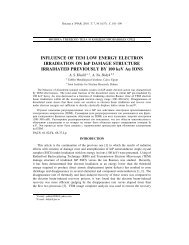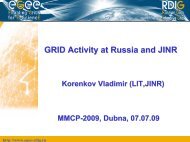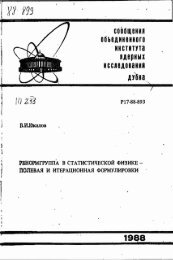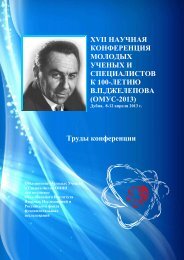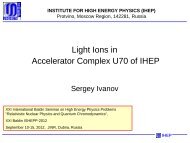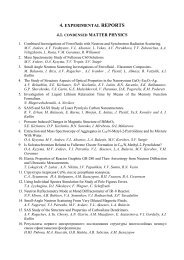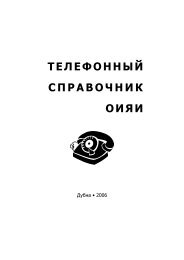Joint Institute for Nuclear Research Relativistic ... - Index of - JINR
Joint Institute for Nuclear Research Relativistic ... - Index of - JINR
Joint Institute for Nuclear Research Relativistic ... - Index of - JINR
You also want an ePaper? Increase the reach of your titles
YUMPU automatically turns print PDFs into web optimized ePapers that Google loves.
BARYON STRUCTURE IN AdS/QCD<br />
V.E. Lyubovitskij 1,2† , T. Gutsche 1 , I. Schmidt 3 , A. Vega 3<br />
(1) Institut für Theoretische Physik, Universität Tübingen,<br />
Kepler Center <strong>for</strong> Astro and Particle Physics,<br />
Auf der Morgenstelle 14, D-72076 Tübingen, Germany<br />
(2) Department <strong>of</strong> Physics, Tomsk State University, 634050 Tomsk, Russia<br />
(3) Departamento de Física y Centro Científico Tecnológico de Valparaíso (CCTVal),<br />
Universidad Técnica Federico Santa María, Casilla 110-V, Valparaíso, Chile<br />
† E-mail: valeri.lyubovitskij@uni-tuebingen.de<br />
We develop the s<strong>of</strong>t-wall model (bottom-down AdS/QCD approach) <strong>for</strong> description <strong>of</strong><br />
baryons [1]-[4]. As application we present a detailed analysis <strong>of</strong> nucleon electromagnetic<br />
and axial <strong>for</strong>m factors in a holographic s<strong>of</strong>t-wall model [2]. This approach is based on<br />
an action which describes hadrons with broken con<strong>for</strong>mal invariance and incorporates<br />
confinement through the presence <strong>of</strong> a background dilaton field [1]-[6]. For N c = 3 we<br />
describe the nucleon structure in a superposition <strong>of</strong> a three valence quark state with high<br />
Fock states including an adjustable number <strong>of</strong> partons (quarks, antiquarks and gluons)<br />
via studying the dynamics <strong>of</strong> 5D fermion fields <strong>of</strong> different scaling dimension in antide<br />
Sitter (ADS) space. According to the gauge/gravity duality the 5D fermion fields<br />
<strong>of</strong> different scaling dimension correspond to the Fock state components with a specific<br />
number <strong>of</strong> partons. In the present application we restrict to the contribution <strong>of</strong> 3, 4<br />
and 5 parton components in the nucleon Fock state. With a minimal number <strong>of</strong> free<br />
parameters (dilaton scale parameter, mixing parameters <strong>of</strong> partial contributions <strong>of</strong> Fock<br />
states, coupling constants in the effective Lagrangian) we achieve a reasonable agreement<br />
with data <strong>for</strong> the nucleon <strong>for</strong>m factors.<br />
References<br />
[1] T. Gutsche, V.E. Lyubovitskij, I. Schmidt, A. Vega, Phys. Rev. D85, 076003 (2012)<br />
[2] T. Gutsche, V.E. Lyubovitskij, I. Schmidt, A. Vega, arXiv:1204.6612 [hep-ph], Phys.<br />
Rev. D86, (2012) [in print]<br />
[3] A. Vega, I. Schmidt, T. Gutsche, V.E. Lyubovitskij, Phys. Rev. D83, 036001 (2011)<br />
[4] A. Vega, I. Schmidt, T. Gutsche, V.E. Lyubovitskij, Phys. Rev. D85, 076003 (2012)<br />
[5] T. Branz, T. Gutsche, V.E. Lyubovitskij, I. Schmidt, A. Vega, Phys. Rev. D82,<br />
074022 (2010)<br />
[6] A. Vega, I. Schmidt, T. Branz, T. Gutsche, V.E. Lyubovitskij, Phys. Rev. D80,<br />
055014 (2009)<br />
90


